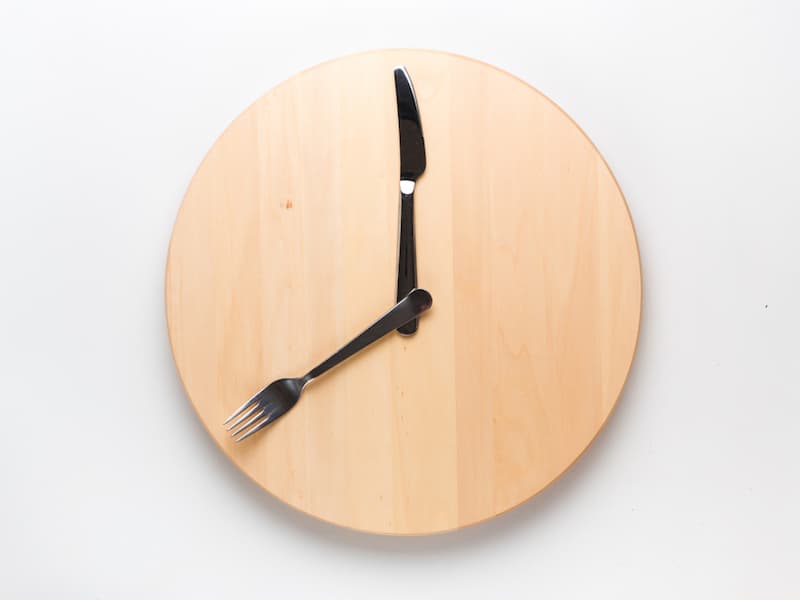What Is Intermittent Fasting?

February 22, 2019

There are so many options and trends out there when it comes to healthy eating, so it’s understandable if you sometimes get confused about which nutrition approach will best suit you and your goals.
A healthy lifestyle should be all about balance. A healthy lifestyle should allow you to enjoy yourself — finding a way to reach your health and fitness goals without restricting yourself. Often, limiting certain foods that you love can be very hard to maintain.
With that in mind, today we’re talking about intermittent fasting, an approach to eating habits that has become increasingly popular. Many members of the Sweat community have been curious about the topic of intermittent fasting, so we’ve provided some insight into this talked-about method.Jump to:
What is intermittent fasting?
Intermittent fasting is an eating pattern (instead of an eating plan) that is broken into distinct periods of eating which are then followed by periods of fasting. Unlike a diet which dictates what kinds of foods you should eat, intermittent fasting only dictates when you should eat.
Depending on the type of method used, individuals can fast between 16 and 24 hours, sometimes even longer. In this time, they do not eat any solid food but can have unlimited water and beverages such as black coffee, tea and zero-calorie drinks.
Why has intermittent fasting gained popularity in recent times? It has been argued by some that intermittent fasting may lead to a range of health benefits, including decreases in weight and disease risk.
So how does it work?

Types of intermittent fasting
The some common methods of the intermittent fasting diet are:
16:8 method
This type of intermittent fasting involves eating within an eight-hour window and to fast for the remaining 16 hours. For example, if you were following this method, you might eat as usual between 11am and 7pm and then fast for the remaining hours of the day.
In this case, a majority of the fasting hours may be actually spent sleeping. It does NOT require you to count calories — simply eat as you normally would within what is known as the ‘eating window’.
5:2 method
This method involves eating as you normally would for five days of the week and eat one quarter (generally about 500 to 600 calories) of your daily calorie needs for the remaining two days of the week. For example, Monday to Friday you can eat as you normally would and on Saturday and Sunday you may choose to eat 500-600 calories per day. To ensure you don’t go over the suggested calorie count on fasting days, tracking calories may be necessary.
Alternate day fasting
As the name suggests, this method involves alternating between days of eating as you would normally with days that consist of one meal that provides about 25% of your daily calorie needs. For example, you might choose to fast on Monday, Wednesday and Friday and eat as you normally would on other days.
One meal per day (OMAD)
When following this intermittent fasting pattern all the nutrition for the day is condensed into a single meal — usually the evening meal, but it can be at any time of day. This means fasting for 23 hours of the day, and consuming all of your food for the day within a single hour.
When following the OMAD diet, you might follow this eating structure for one day of the week initially, to determine how your body responds to the extended fasting window.
How does intermittent fasting affect your body?
Potential weight loss
All weight-loss diets have something in common — reducing calorie intake. While intermittent fasting is a pattern of eating rather than a diet, it still achieves the same result of reducing the amount of calories you eat over time.
With alternate day fasting and the 5:2 method, you limit the amount of calories you eat on certain days which reduces your total intake over the week.
The 16:8 style of intermittent fasting can reduce your total calorie intake as it often leads to eating less than you normally would. This might be because you’re not eating meals that you would normally, or it might mean that you eat less because you feel more full within the short period of time that you do eat.
Intermittent fasting is often associated with weight loss because it can help to lower insulin levels. Insulin is a hormone that has two main roles:
It helps your body turn sugars from food into energy.
It stores excess sugars as fat which can be used for fuel when needed (for example, between meals or when you are sleeping).
When we eat, insulin levels are high as we draw energy from our food and store away any excess. Between meals, insulin levels drop and stored fat can be broken down to be used as energy.
Essentially, intermittent fasting has the potential to increase the time your body has to burn fat between meals and may therefore be used to help increase weight loss.
This isn’t the only way your body can burn fat though! If fat loss is your goal, research indicates what kicks this process off is how many calories you eat per day overall, not when and how often you eat.
So whether you choose to eat three larger meals within a shorter frame of time or five small meals spanned out evenly over the day, you can still lose fat if your calorie intake is less than your calories burned.
Risks associated with this
It might be easy to think that you can eat whatever you like during your “eating window” or that you can eat more to compensate for meals you’ve skipped. But unhealthy food choices may lead to nutrient deficiencies, lack of energy, or it can actually lead to weight gain if you end up eating more than you normally would. As a rule, it’s important to eat a range of nutritious whole foods, to ensure you’re feeling your best.

Autophagy
It is believed that intermittent fasting may stimulate ‘autophagy’, a natural process in which the body gets rid of and recycles cells that have been damaged. Think of it as your body’s form of housekeeping. An accumulation of too many damaged cells can lead to disease and signs of ageing.
Exercise and intermittent fasting both trigger autophagy by putting your body under a mild form of stress. Stress is often seen as negative, but it can actually be positive in small amounts. It signals to your body to protect itself when there is a perceived danger and makes your cells more resilient in the long term.
Your body senses a threat of possible starvation when you go for extended periods without food. Aside from drawing upon your back-up stores of energy (such as fat), the body’s immediate response is to remove and recycle any cells that may cause further danger to your body to increase your rate of survival. Intermittent fasting is intended as a way to trigger the autophagy process without actually experiencing any real danger.
How to achieve autophagy without intermittent fasting
If you want to experience the benefits of autophagy without having to do intermittent fasting, then consider including exercise in your routine if you haven’t already!
Exercise is another way of inducing small amounts of positive stress on the body and therefore promotes the natural process of autophagy.
Hunger
Have you noticed that you get hungry at the same time every day? Some people don’t feel hungry at all in the morning while others might be ravenous!
Everyone experiences hunger at different times depending on their individual metabolism and how often they eat. If you eat breakfast at the same time every day and then one day you skip it, you are more likely going to feel really hungry! Your body gets used to whatever eating schedule you train it with.
Intermittent fasting may leave you feeling hungry, tired and unable to concentrate when you remove a meal that your body has been used to receiving at a certain time. This initially leads to an increase in a hormone called Ghrelin, known as ‘the hunger hormone’.
However, if that hunger is not fulfilled within about two hours, the hunger passes as Ghrelin decreases. You might have noticed that this wave of hunger has happened to you previously when you’ve had a busy day and haven’t had time to eat — you suddenly realise the feeling of hunger has come and gone.
As long as you’ve eaten an adequate amount of food within the last 24 hours, your body should be able to use its energy stores in between meals to keep your brain and body functioning. However, if you’re already under a lot of stress, skipping that meal might not be so good.
Why? Fasting stimulates Cortisol, the stress hormone, which can be beneficial in small amounts but harmful if you already suffer from issues related to high cortisol levels. In this specific case, intermittent fasting may not be for you.
Remember, if you’re not feeling well on any kind of eating plan, you should stop immediately and speak to your health care professional as it might be causing more damage than good.
Intermittent fasting safety
Intermittent fasting is not a way of eating that suits everyone. In fact, if you have any of the below conditions, then intermittent fasting should be avoided:
Diabetes.
A history of disordered eating (particularly those involving self-restriction).
Using medications that require food intake.
Experiencing an active growth stage, such as adolescence.
Pregnant or breastfeeding.
If you are underweight.
As with any health concerns or changes to your diet, it is important to talk to your healthcare professional before you start any sort of new eating regime.
Intermittent fasting and exercise
If you are active and are considering intermittent fasting, keep in mind how your workout fits around your eating schedule.
Some of us feel fine working out in a fasted state but others can feel flat, nauseated and light-headed when doing fasted cardio or any intense activity before having a meal. This is ultimately up to you to decide if intermittent fasting can be scheduled appropriately to work around your training.
A healthy lifestyle is all about balance
Remember, there’s no amount of intermittent fasting that can overcome a poor diet or an unhealthy lifestyle!
Whichever pattern of eating you choose to follow, it’s important to prioritise eating nutrient-dense, wholesome, high-fibre foods and make sure it’s something that you’re able to maintain in the long term.
If intermittent fasting doesn’t sound like your thing, rest assured there are still other ways to achieve your health and fitness goals. Whatever approach you choose to take on your health journey, the key is to be consistent, maintain a healthy relationship with food and to live a balanced lifestyle!

A more empowered you starts with Sweat, and our editorial team is here to bring you the latest fitness tips, trainer recommendations, wellbeing news, nutritional advice, nourishing recipes and free workouts.
* Disclaimer: This blog post is not intended to replace the advice of a medical professional. The above information should not be used to diagnose, treat, or prevent any disease or medical condition. Please consult your doctor before making any changes to your diet, sleep methods, daily activity, or fitness routine. Sweat assumes no responsibility for any personal injury or damage sustained by any recommendations, opinions, or advice given in this article.
Nutrition